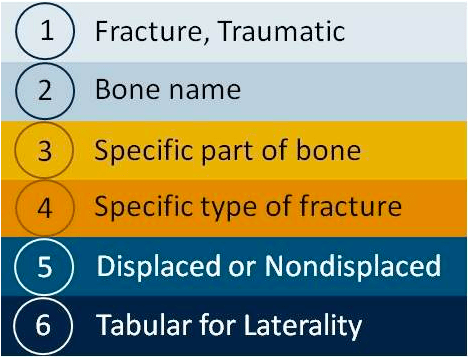ICD-10-CM: Overview of Traumatic Fractures
By Lynn Kuehn, MS, RHIA, CCS-P, FAHIMA
Traumatic fractures are coded in ICD-10-CM chapter 19. Within the categories that describe fractures, subcategories identify the most common types of fractures for the specific bone identified in that code category.
Terms such as transverse, spiral or comminuted can be found in these subcategories. When clinically possible, subcategory codes are available for displaced fractures and non-displaced fractures. There are no individual codes for open vs closed fractures. Rather, this information is captured in the 7th character. Laterality is almost always included in the specificity for the fractured bone.

Guideline I.C.19.c says that the principles of multiple coding of injuries should be followed in coding fractures. Fractures of specified sites are coded individually by site and by following all Excludes1, Excludes2 and Coding notes located in the tabular listing. Multiple fractures are sequenced based on the severity of the fracture.
This guideline also reminds the coder that a code from category M80, not a traumatic fracture code, should be used for any patient with known osteoporosis who suffers a fracture, even if the patient had a minor fall or trauma, and if that fall or trauma would not usually break a normal, healthy bone.
Defaults
A fracture not indicated as being open or closed should be coded to closed. A fracture not indicated as being displaced or not displaced should be coded as a displaced fracture.
Indexing Traumatic Fractures
Start with the main term of Fracture, traumatic and make sure you are seeing codes that begin with S or rarely a T. The main term of Fracture, pathologic comes first in the index and will display codes which begin with M. Correct coding starts with verifying the main term as having entries for traumatic fractures.
Then, reference the subterm for the individual bone that is fractured. Scan these entries for any additional specifics that may be documented in the record about the fracture, such as a unique fracture type or location on the bone, or whether it is displaced or non-displaced. Also, follow any indexing cross-references to assign the most accurate code. Shown here is the index example for traumatic fracture of the fibula.
Here’s an indexing example Our documentation states Transverse, nondisplaced fracture of the right fibular shaft. The index entry for this traumatic fracture is shown above.

Indexing traumatic fractures
